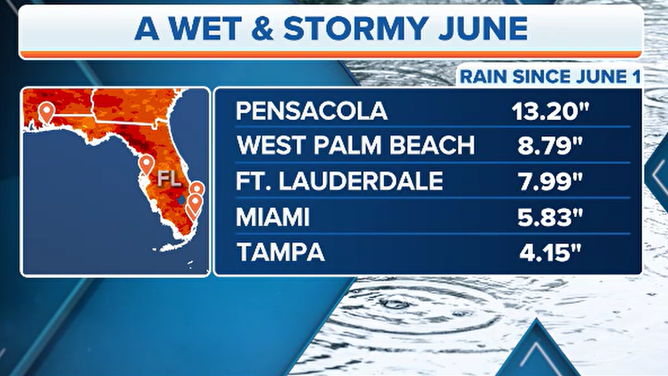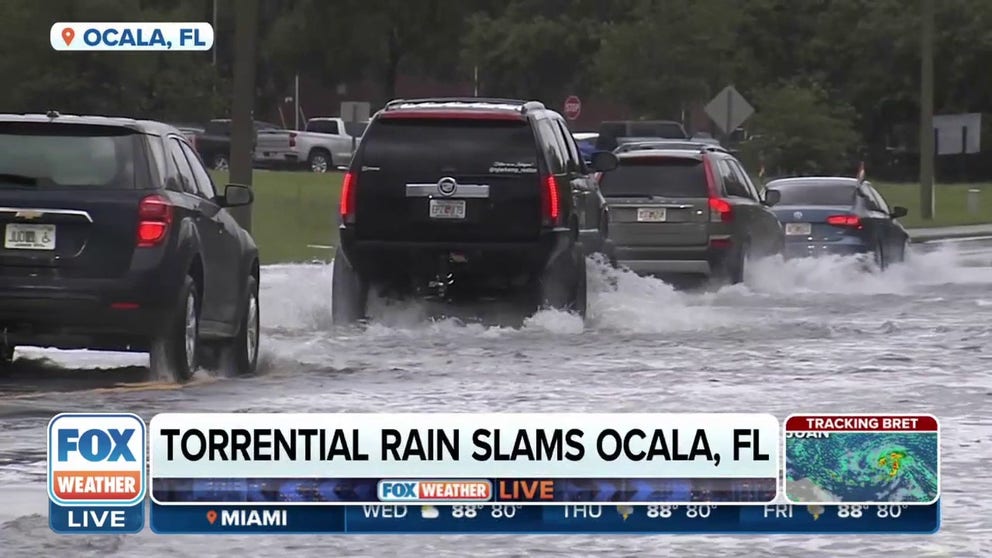Florida’s drought turns to deluge with daily rounds of storms
Due to the abundance of rainfall, some communities in north-central Florida have experienced flooding and problems with erosion. Storms during the summer are a regular occurrence but are usually more widely scattered.
Torrential rains flood north Florida
Heavy rains pounded the Southeast on Tuesday. Ocala, Florida, used to afternoon summer thunderstorms quickly became overwhelmed. Streets looked more like canals.
Daily rounds of showers and thunderstorms have all but erased the Sunshine State’s rainfall deficit, ending concerns that significant wildfire activity would continue.
Major cities such as Jacksonville, Orlando, Tampa and Miami all accumulated significant rainfall deficits during the spring, but like clockwork, the wet season kicked into overdrive during the early summer.
Over half of the state experienced drought conditions, and since June 1, the Florida Forest Service reported nearly 85,000 acres had been destroyed by wildfires.
Now, imagery coming out of the state is much different, with low-lying flooding and erosion issues impacting some communities.
Pensacola has reported more than a foot of rainfall over three weeks, with many other communities seeing half a foot of precipitation since June 1.
WILDFIRES GROW IN FLORIDA AMID INTENSIFYING DROUGHT

Wet & stormy June for the Sunshine State
(FOX Weather)
Flooding woes
In some communities, the rainfall was too much of a good thing as drainage systems were maxed out by all the water.
Pensacola was put under a Flash Flood Emergency during the overnight hours of June 16, and local authorities reported helping hundreds to higher ground.
In north-central Florida, communities experienced a 1-in-100-year flood event with more than 5 inches of rainfall falling in two hours.
All the rainfall is likely the cause of the opening of a depression in Ocala that measured 30 feet wide and forced evacuations.
Residents were encouraged to stay out of flood areas due to pollutants possibly being in the water.
Mosquito worries
The combination of warm temperatures and plenty of standing water is also leading to concerns over mosquitoes and the spread of diseases and viruses.
The Florida Department of Health reported Manatee, Miami-Dade and Sarasota counties were put under mosquito-borne illness alert, and Orange and Polk counties were under advisories due to detections of potentially harmful mosquitoes.
Along the west coast of the state, authorities have confirmed at least two cases of malaria, which are thought to be the first locally transmitted cases in more than a decade. The Centers for Disease Control and Prevention said people impacted by the disease often experience a fever, chills and other flu-like symptoms. Severe cases of the disease lead to more than 600,000 deaths worldwide a year.
NEW TO FLORIDA? HERE’S WHEN THE SUNSHINE STATE’S RAINY SEASON GETS UNDERWAY

Drought monitor for Florida
(FOX Weather)
Florida's rainy season
According to climatology, the rainy season usually ends in early to mid-September.
The FOX Forecast Center said that during the fall, attention turns to the threat posed by tropical systems and if any cold fronts can make it into the state.
During El Niño years, a downtick in tropical cyclone activity in the Atlantic basin can lead to a reduction in named storms, but no two climate events are the same.
In 2004, an El Niño pattern led to a historic season with four significant hurricanes impacting the state.
Slow-moving tropical cyclones can produce a foot of rain or more, and if grounds are already saturated, flooding becomes a significant event in the impact zone.

Hurricanes Jeanne, Frances, Charley and Ivan impacted Florida during the 2004 hurricane season.
(FOX Weather)
